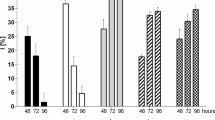Abstract
The toxic effect of multi metals mixture which exist simultaneously in aquatic ecosystem on natural phytoplankton assemblages (green algae, blue-green algae and diatoms) was studied. For this purpose a laboratory scale unit was designed to evaluate the effect of continuous flow metals mixture in forms if triple and penta metals in Nile water algae. Clear changes in algal biomass in terms of chlorophyll a (chl a) took place when subjected to metals combination. The rise or decline in chl a was in relation with other algal pigments (chl b, chl c, carotenoides and phenophytin), protein and carbohydrate content of algal cells. Substantial changes in phytoplankton community structure was detected and the most tolerant group was blue-green algae followed by green algae while diatoms was the most sensitive group. The most dominant species in all cases were blue-green alga Oscillatoria mougeotii and green alga Scenedesmus quadricauda. In addition clear changes in morphological shape was observed for tolerant species belonging to the three algal groups. Nile water algae has ability to remove and accumulate metals in the following order therefore Zn > Cd > Ni > Cu > Cr. In addition, phytoplankton has ability to recovered from the stress of metals when eliminated from the media and the recovered biomass was nearly equivalent to that before exposing to metals stress. The overall effect of metals mixture depending on the type and number of metals, the algal community structure and ratio between different morphological forms of algae (unicellular, colonial and filamentous).
Similar content being viewed by others
References
Angadi, S. B. and Mathad, P.: 1994, Phykos. 33, 1–99.
Aoyama, I. and Okamura, H.: 1993, Environ. Toxical. Water-Qual. 8(3), 255.
Chapman, H. D. and Pratt, P. F.: 1978, Methods of Analysis for Soils, Plants andWaters, PP. 50 Univ. of California Div. Agric. Sci., Priced Publication 4034.
Cid, A., Herrero, C., Torres, E. and Abalde, J.: 1995, Aquat. Toxical. 31(2), 165.
Conglianese, M. P. and Martin: 1981, Mar. Environ. Res. 5, 13.
Conway, H. L. and Williams, S. C.: 1979, J. Fish. Res. Board Can. 36, 579.
Devlin, R. M.: 1975, Plant Physiology, Affiliated East-West Press, 2ndEd.
Dubois, M., Gilles, K. A., Hamilton, J. K., Rebers, P. A. and Smith, F.: 1956, Analytical Chemistry 28(3), 350.
Environmental Protection Agency: 1975, U.S.A. Quality Criteria for Water, Washington, C. D.
Gale, N. L. and Wixson, B. G.: 1979, Removal of Heavy Metals from Industrial Effluents by Algae, from volume 20 of Development in Industrial Microbiology. Apublication of the Society for Industrial Microbiology.
Hart, B. A.: 1975, 'Bioconcentration and Toxicity of Cadmium in Chlorella pyrenoidosa', in the Effect of Cadmium on Freshwater Phytoplankton, Office of Water Research and Technology. Washington, DC, PB 257–24, pp. 1–31.
Hollibaugh, J. T., Seibert, D. L. R. and Thomass, W. H.: 1980, Canada Estuarine Caostal Marine Sci. 10, 93.
James, R., Sampath, K., Sivakumar, V. and Manthiramoorthy, S.: 1991, Ind. J. Fish. 38, 49.
James, R., Sampath, K. and Punithavathi Ponmani, K.: 1992, Ind. J. Expt. Biol. 30, 496.
Matulova, D.: 1991, Arch. Protistenkd. 139, 279.
Monteiro, M. T., Oliveira, R. and Vale, C.: 1995, Water Res. 29, 695.
Munawar, M. and Munawar, L. F.: 1982, Can. J. Batany 60, 1837.
Pascucci, P. R.: 1993, Analytical letters Analbp 26(3), 445.
Singh, H. N., Vaishampayan, A. and Singh, R. K.: 1978, Biochem. Biophys. Res. Commun. 81, 67.
Standard Methods for the Examination of Water and Wastewater: 1992, APHA, AWWA, WPCF. N.W. Washington.
Starmch, K.: 1966, Flora Slodkowodna Polski Cyanohyta Sinica Glaucophyta, glaukofity Tom 2 Polska Akademia NAUK.
Streble, H. and Krauter, B.: 1978, Das Leben in Wassertropfen, Mikroflora and Microfauna des Subasser, Ein Bestimmungsbuch mit 1700 Abbildungen. Stuttgart.
Visviki, I. and Rachlin, J. W.: 1994, Arch. Environ. Contam. Toxical. 26(2), 154.
Voyer, R. A. and Heltshe, J. F.: 1984, Water Res. 18, 411.
Whitton, B. A. and Kelly, M. G.: 1995, Aust. J. Ecol. 20(1), 45.
Wong, P. T. S., Chau, Y. K. and Luxon, P. L.: 1987, J. Fish. Res. Bd. Can. 35, 479.
Author information
Authors and Affiliations
Rights and permissions
About this article
Cite this article
Shehata, S.A., Lasheen, M.R., Ali, G.H. et al. Toxic Effect of Certain Metals Mixture on Some Physiological and Morphological Characteristics of Freshwater Algae. Water, Air, & Soil Pollution 110, 119–135 (1999). https://doi.org/10.1023/A:1005058607002
Issue Date:
DOI: https://doi.org/10.1023/A:1005058607002




